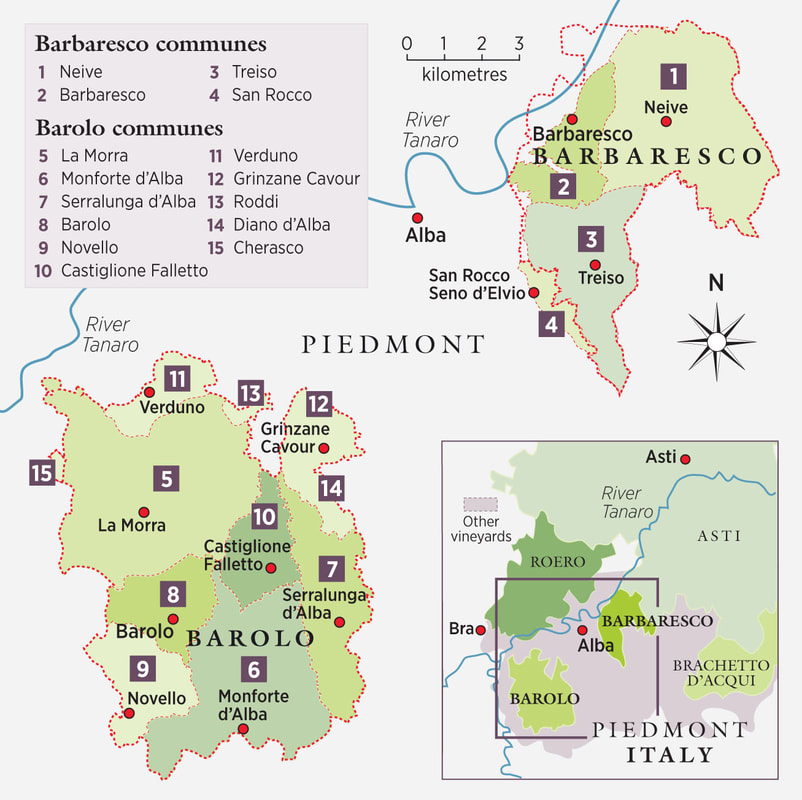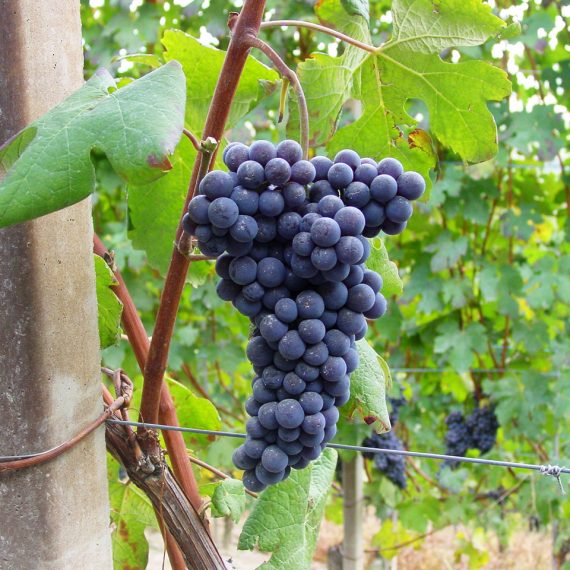Piedmont Piedmont borders France and Switzerland and sits at the foot of the Alps. Here the terrain rises to elevations of 1500 feet and drifts south to the fertile Po River Valley. The Alps protect the hills of Piedmont but can bring weather events like hail, frost and winds. The boom of air cannons reminds those in the vicinity of the on-going efforts to protect the vineyards from hail. Temperatures are monitored closely as are forecasts. Frost in the spring and fall are problematic in this hilly region. Fogs cling to the vineyards offering sometimes protection and sometimes death. Mists keep humidity in and breezes keep disease out. It’s miraculous that vintages succeed here in Italy famous gastronomic paradise. UNESCO Site Piedmont is the second largest wine region in Italy. More than half of the land is a UNESCO world heritage site which includes 170 thousand acres of vineyard. Here in Piedmont there are 42 DOCs and 17 DOCGs - more than any other region in Italy. Piedmont (Piemonte) is famous for its grippy, powerful, long lived red wines the world over! Mention Barolo and Barbaresco and heads around you will nod, knowingly. There are however, many other reds that live in the shadow of these hallowed wines. In fact, wines produced from the same grape, Nebbiolo, can deliver a similar experience for a much lower price. Other red grapes from Piedmont such as Barbera and Dolcetto from both Asti and Alba, are great choices that work well with a wide variety of dishes with everyday drinkability at a fraction of the price. Barolo & Barbaresco Barolo Barolo is a DOCG zone covering 3100 acres in 11 communes that lie to the south of the city of the same name. Here single vineyard crus are sought after at prices ranging from hundreds to thousands of dollars depending on the vintage and producer. The five communes or zones are La Morra, Barolo, Monforte d'Alba, Castiglione Faletto, and Serralunga d'Alba. Vineyard work is by hand. Wine making is rigorous in that ageing for extended periods of time is essential to protecting styles here. Barbaresco Barbesco was one of the first DOCs in Italy in 1966, moving to DOCG status in 1980. The area covers 1200 acres over 5 communes. Barbaresco lies in the north east and east of Alba. Famous vineyards here include Sori Tildin, Sori San Lorenzo, and Costa Russi all owned by Angelo Gaja. Wine-making Traditional wine-making in Barolo part of the ethos here. Fermenting Nebbiolo in large casks called "botti" made of chestnut or Slovenian oak at a capacity of 50 hectolitres is where these wines take shape. 100% Nebbiolo ferments can stay on the skins for two weeks to two months, depending on the desired level of tannin and flavour. As these wines develop, they often display a garnet rim, a characteristic of age, with delicate floral, earthy notes. In many cases these wines require a couple decades in the cellar before reaching that “ready to drink" status. Minimum alcohol requirements for Barolo is 13% abv, and 12.5% abv. for Barbaresco. Modern wine making is challenging traditionalists with use temperature controlled technology during fermentation and the use of smaller French Oak barrels. The result is richer, fruitier wines styles with less oxidized color and styles that mature more readily. Ageing Requirements Barolo and Barbaresco have strict rules when it comes to minimum requirements for ageing. Barbaresco must be aged at least two years before release, of which 9 months is spent in oak barrels. Riserva can appear on the label if the wine has been aged a minimum of 4 years with a minimum of 9 months in oak. Barolo requires a minimum of three years, of which with 18 months in oak barrels. Riserva can appear on the label if the wine has been aged for an additional two years. This sets the minimum for barrel ageing at 42 months and bottle age at 18 months. Key Red Grapes of PiedmontNebbiolo is the most important grape variety in Piedmont. It is a thin skinned grape variety that is indigenous to this region, dating back to the 1300s. This is a late ripening variety that is a sensitive personality. Nebbiolo produces wine that is light to medium ruby yet packs flavour and power which makes it a grape to ponder over. Barbaresco, Barolo and Langhe wines are 100% Nebbiolo. Barbera is the most widely planted grape variety in Piedmont. Its origins are the Monferrato hills. It is a heartier, higher yielding variety that grows well in and around Piedmont which can lead to a wide range of style. Labels will usually display the grape variety and then the zone e.g Barbera d’Asti. Aromas and flavours are bright red fruit (berry) and sour cherry, medium in body with good acidity and an excellent companion of grilled white meats like chicken in pork. Dolcetto means the "little sweet one". It is sweet when ripe but the resulting wine is dense, dry with ripe black fruit, like berry and plum with spice, soft smooth and round. Like Barbera, usually labels display name of zone on the label e.g. Dolcetto d’Alba. Learn more... If you would like to learn more about Piedmont and the red wines of North West Italy, join us Thursday at 7:30 pm with Mark Shipway, Vancouver's top wine educator as we take a virtual tour and taste wines from our favorite gastronomic region. Click this link to get more information on Barolo & Beyond.
0 Comments
Leave a Reply. |
AUTHORI'm Good Wine Gal.
I blog about "good wine" and how to find it! Join me on my adventures of finding beautiful wine loving places, people and those special bottles we all get excited about. Archives
July 2024
|
Photos from Magnus Reuterdahl, wuestenigel, Fareham Wine







